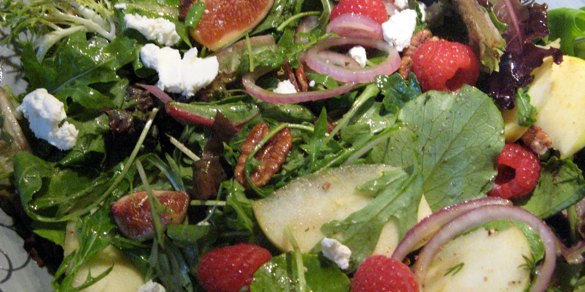
A standout dressing can elevate salad from a mundane side dish to the astonishing show-stopper that has diners coveting every last morsel. Pictured here, a melange composed during the waning days of summer.
Recently a friend of mine requested a column devoted to the basics of salad dressing. I consider this wise, practical advice, grounded in everyday kitchen reality. It reminded me that lots of folks don’t get how quick and easy it is to throw together delicious homemade salad dressing or that a standout dressing can elevate salad from a mundane side dish to the astonishing show-stopper that has diners coveting every last tasty morsel.
I grew up in an era that took advantage of newly available convenience foods like Stouffer’s frozen casseroles and Campbell’s canned soup – it followed logically that our salad dressing came from a bottle. Not that I’m averse to some amount of convenience in the pantry – we’ve got a few cartons of Trader Joe’s Tomato and Roasted Red Pepper Soup nestled beside the canned beans and breakfast cereal. There are a considerable number of packaged items I deem truly essential to a well-stocked larder like the aforementioned TJ’s soup, canned tomatoes and beans, tortillas and frozen samosas, just to name a few. I have to point out that breakfast cereal is not on my list – just my husband’s – but I digress.
While I concede that investment in a little processed food is helpful (possibly even critical) to maintaining a harmonious household in which kind words are spoken at times of intense hunger, I have learned over the years that not all are created equal. The thing is, when a dish is simple and speedy to whip up and tastes infinitely better freshly made, why turn to the packaged version? If we aren’t buying time or quality, what’s the point? Convenience food should be reserved for the evening when you’ve dashed home from work and don’t have the energy or necessary interval to peel, chop and simmer up a pot of comforting homemade soup. The hungry masses are ready to eat – NOW!
When a recipe requires five minutes to prepare, this is not a Campbell’s soup moment. Salad dressing falls squarely into this realm – it’s pretty darn convenient to make and far superior. If you’ve been using bottled dressing, you might reconsider. It’s possible you’re looking at the difference between ho-hum lettuce that gets pushed to the side of the plate and a simply sumptuous salad that stands up to the rest of the meal.
In this household most of the dressings we create originate with a classic yet simple formula for vinaigrette. The rule of thumb is to use 3 to 4 parts oil for each part of vinegar. If you like a smoother more mellow dressing, err on the side of adding more oil. For dressing with a little bite or edge, try less. The key is to know your tastes and what your salad needs to shine. Assertive or substantial greens, like arugula and romaine, for instance, pair nicely with a stronger dressing, while delicate baby lettuces ask for treatment a wee bit subtler.
We often wonder when to use extra virgin olive oil versus something cheaper. This is that moment – seize it by turning to the best extra virgin olive oils, nut and seed oils and vinegars in the pantry. The quality of the ingredients will be reflected directly in every toothsome forkful.
Once you have the ratio set for oil and vinegar there are any number of variations made possible by adding spices and herbs, fruit juice, pressed garlic, shallot, mustard and more. Here is where I look to my meal and salad ingredients for inspiration. If I’m going for a French taste, I might opt for adding chopped shallot, mustard or herbs. When I’m serving a fruity salad with berries or citrus I like to add some orange juice, fruit vinegar, crushed berries or a little honey. A Mexican dinner might call for a hint of ground cumin and a splash of lime juice, while an Indian inspired salad begs for fresh ginger, chaat masala or curry powder. A touch of sesame oil, rice wine vinegar, scallions, ginger and garlic create a decidedly Asian twist.


Look to your meal and salad ingredients for dressing inspiration…add some citrus for a fruity taste, turn to pressed garlic and herbs for a classic Mediterranean variation.
There really aren’t any wrong answers to the equation, just proper balance, so that no flavor overpowers the others. Another rule that serves me well in most improvisational cooking – add a bit of an ingredient, let it meld for a minute, then taste. Adjust as necessary. You’ll find that ingredients like garlic, ginger and shallots take time to permeate the dressing fully, so use some restraint at first. You can always add – subtracting isn’t quite so simple.
Here are some ideas for starting points. Feel free to use your imagination as well as what’s in the pantry.

